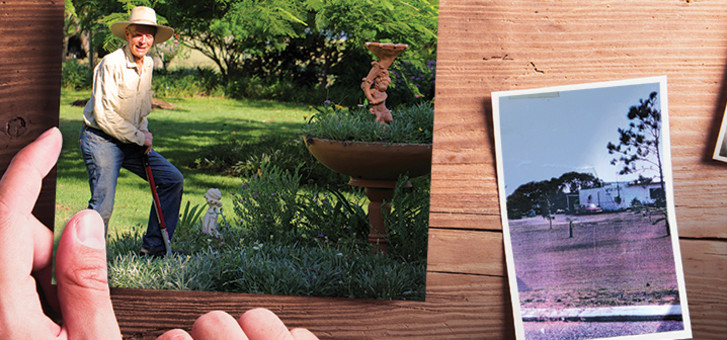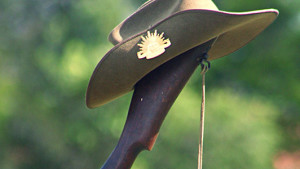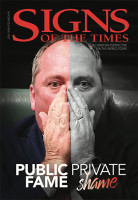On a searing Gold Coast morning, my neighbour, Rollo Meyers, stands in the Runaway Bay park that bears his name, tipping water out of a wheelbarrow. The garden tools and spray bottles stored in the tray clatter noisily to the rim as he angles the barrow toward the ground.
“It rained last night,” Meyers, 78, explains. He’s wearing a long-sleeved white cotton shirt, blue jeans and brown orthopaedic shoes.
He limps over to a giant fig tree, enormous buttress roots like panelling. “This was only a tiny sapling when I planted it,” he says. “It was when my wife was still alive.”
He bends down awkwardly to pull a weed sprouting through the sugar cane mulch.
“And that poinciana over there,” he says as a gust of wind from the broadwater inlet swells through the green ferny leaves of the tree. “That was planted 21 years ago, when my father died.”
“Before this was a park?” I ask.
“Before this was anything. It was just wasteland. There was nothing here at all.”
Beginnings
The “Rollo Meyers Park” was the brainchild of Meyers’ first wife, Christine, a feisty young German Meyers met while working as a dentist in London. Within 12 weeks of meeting they were married and, four years later, he took her home to Australia where they purchased a waterfront house with its own sandy beach in Runaway Bay.
It wasn’t long before Christine noticed the large block of empty land opposite their house. Despite its proximity to the waterfront it was ugly, sunburnt earth, bare but for litter and featuring a handful of straggly bushes trailing dry and dusty leaves. “You should clean it up,” she told Meyers.
“I can’t, it’s council land.”
“So what?” she said.
It wasn’t until Meyers found himself forced into early retirement due to severe osteoarthritis at the age of 48 that he began to give serious thought to his wife’s idea.
He found himself studying the land opposite his house in Runaway Bay. Everything was dead or dying, the loose sand settling in thin drifts over the loam. As he stood there, watching the sun-scorched earth, he thought about his own poor health.
The disease was a particularly cruel blow to Meyers. The only thing he could do, really, was to keep moving. But he hated going to the gym and he disliked being indoors.
He looked at the circular vacant lot bounded by the close. What if he could clean up this dustbowl? Could gardening be the physical therapy that his body so desperately needed?

Back then, the eastern end of Poinsettia Avenue had very little shade, with only a few stark pines and, ironically, not a single poinsettia. It seemed fitting to Meyers that he should start by planting some poinsettias in honour of the avenue’s name.
There was just one hurdle. The soil. “There wasn’t any to speak of,” Meyers says. “The land used to be a marsh, and when they deepened the harbour, all the sand was pumped up onto this block.”
It was Christine who encouraged Meyers to undertake a rigorous soil-improvement program. At first, they bought trailer-loads of soil that Meyers painstakingly dug through the sand. Then they added fertiliser and mulch, and hand-watered the area.
As the soil became healthier they began to plant edibles: a variety of kitchen herbs as well as vegetables. Then they graduated to fruit trees. Pawpaws, limes, banana plants, a macadamia nut tree . . . “And those . . . ” Meyers extends his arm toward several towering palms, beyond which boats bob gently in the marina. “I planted those from coconuts that washed up on the beach.”
Community involvement
Meyers waves as a middle-aged man dressed in a pair of light blue denim shorts and a white polo top approaches us across the lawn. “This is Frank Gould,” Meyers says, shaking his hand. “He was my neighbour three doors down. He and his wife, Ailsa, now keep the parks watered.
“Frank is one of the many people who’ve worked on this place,” Meyers says as Gould wanders away to check the sprinkler heads. “The park became a very social thing. People going on their morning walks would stop and talk. Many of them donated plants from their own gardens.”
Other neighbours volunteered, helping look after the garden and two adjacent blocks of land as well. This was welcome news to Meyers who, by that stage, was spending four or five hours a day in the garden. The neighbourhood coalition started to hold regular meetings and organise working bees, and the Gold Coast’s first ever park care group—the Poinsettia Park Care Group—was formed.
“What did the council say?” I ask.
Meyers laughs. “The council was pretty haphazard,” he says. “They didn’t even notice how much the land was improving.”
Others, however, were more appreciative. Dr Sheelagh Wennersten, who was assistant co-ordinator of the park care group, approached the council with a request to formally designate the land “Rollo Meyers Park”.
The council agreed to the request, and the park was officially named in 1994. Meyers’ elation, however, was tempered with the realisation that having a park that bore his name came with a deeper sense of responsibility.
Several years later the park care group, who were by now looking after more than two hectares of public land, discovered that the local yacht club wanted to acquire some of the land in order to extend their carpark and build a pokies club.
The Poinsettia Park Care Group went into immediate action. They printed HANDS OFF OUR PARKS! pamphlets and distributed hundreds of them in neighbouring streets, calling for an urgent public meeting the following Sunday at the park.

The response was overwhelming. “People came from all over, because they knew that if it happened to us, it could happen to them, too,” Wennersten told me when I spoke to her over the phone.
At the meeting, Wennersten and her husband proposed an idea. What if they were to name these adjacent parks after Meyers as well?
Meyers, however, declined—he felt that the name did not give credit to the dozens of other people who worked on the parks. In the end a compromise was reached. The smaller garden park remained the “Rollo Meyers Park” and the adjacent parks became “Poinsettia Park”.
Despite this opposition the yacht club ploughed ahead with its attempt to acquire the land. Debate was passionate and, when the club’s application was finally rejected by the council, the park care group held a large party in the park to celebrate.
“I discovered how much the local community had come to value the parklands,” Meyers says.
Rest in peace
But if the community loved the parks, there was someone who loved them even more: Christine. “She had this olive tree,” Meyers says, squinting in the full glare of the noonday sun as we walk slowly back across the road to the garden. “She nursed it for nine years, fertilising it and watering it. Finally, in the last year of her life, just before she died, it flowered and produced olives.”
For more than 30 years Meyers had battled osteoarthritis and prostate cancer as well as undergoing three heart bypass surgeries, and yet it was his wife who passed away early. Christine was only 66 years old when, in 2007, she was diagnosed with pancreatic cancer. Nine weeks later she was dead.
We reach the garden’s centre feature, a birdbath with a cherub playing a horn in its bowl. Meyers falls silent, picking debris from the profusion of yellow gazanias growing in the bowl.
“We scattered half of her ashes under the native hibiscus tree and half of them around the birdbath,” Meyers says. “We came out to this spot when we knew she was dying and it was an unspoken, mutual understanding between us that this was the place where she would stay.”
We cross the lawn. A short way from the “Rollo Meyers Park” sign is a bench. Inscribed upon the metal plaque riveted to the back rest are the words: “In loving memory of Christine Meyers for her loving care and nurturing of the park.”
I watch Meyers hobble to the bench and kneel at the edge of the concrete slab anchoring the legs of the seat, light through the trees shining on his silver hair and bowed shoulders. He pushes aside the dried grass and fallen leaves.
“One of the park care group members wrote a verse on the concrete here while it was setting,” he says. “It’s worn away with time, unfortunately.”
“What did it say?” I asked.
“It was a quote by Helen Steiner Rice.” He takes a deep breath. “The more you give the more you get, the more you share the less you fret.”
He holds my gaze, eyes welling.
This article first appeared in our sister magazine, Mums At The Table.






